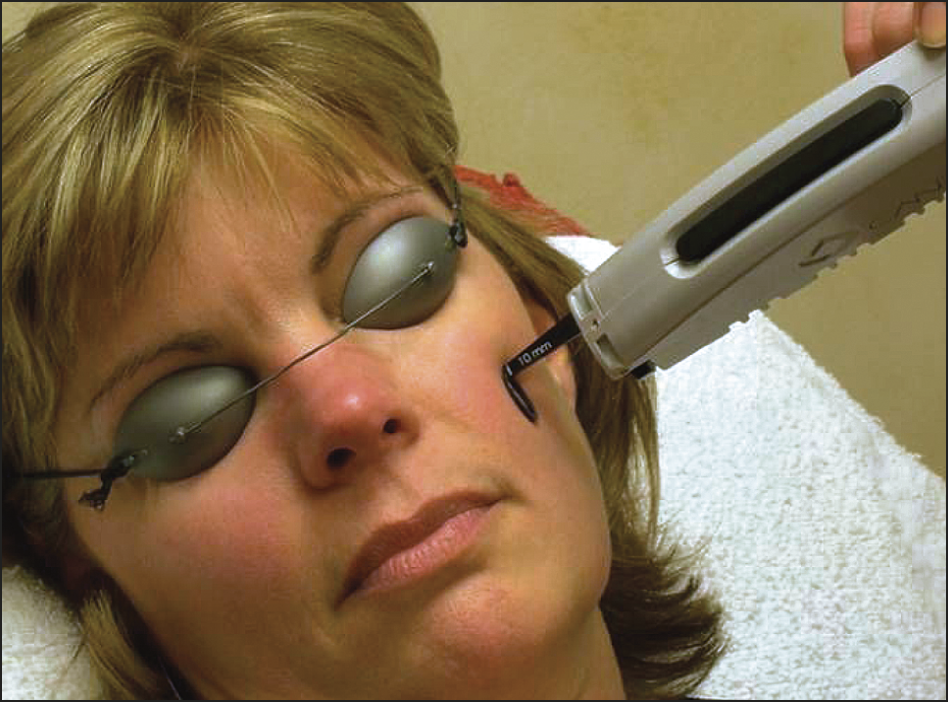Anti- Redness Lasers
What They Treat: The redness of rosacea, sun damage, spider veins, cherry angiomas (red moles). Fresh stretch marks, some types of scars, port wine stains, and superficial bruises.
How they work: By taking aim at hemoglobin, a protein in red blood cells, vascular lasers — namely the pulsed dye laser (PDL), and the KTP laser — heat and destroy blood vessels. Powered by actual dye (who knew?), a Pulsed Dye Laser, like the Vbeam Perfecta, "produces pulses at the 595 nanometer (nm) wavelength, which travels through the epidermis and dermis to reach its target while sparing the surrounding tissue," explains Idriss. A KTP laser uses a potassium-titanyl-phosphate crystal to shoot a wavelength of 532 nm. ("K," you might recall, is the symbol for potassium on the periodic table.)
"The PDL's wavelength and more rapid pulse width make it helpful for diffuse background pinkness, which arises from millions of extremely tiny individual blood vessels," Anolik says. The Pulsed Dyed Laser can also eviscerate the microscopic red blood cells comprising bruises (at certain stages, anyway). Bigger, deeper red squiggles and spots (like cherry angiomas) tend to respond better to KTP lasers, sometimes clearing immediately after treatment. (Fading scars, stretch marks, birthmarks, and resistant capillaries commonly require repeat appointments.)
Vascular lasers, despite being around for decades, are now being explored for their integral role in scarless skin cancer treatments — more specifically, as part of emerging combination therapies for basal and squamous cell cancers. "Eighty percent of non-melanoma skin cancers are on the head and neck — highly visible areas — which is why noninvasive diagnosis and management have become real game-changers for many patients," says Orit Markowitz, an associate professor of dermatology at the Icahn School of Medicine at Mount Sinai. While the laser's mechanism of action in this realm is still being investigated, Markowitz says, "cutting off blood supply to tumors is likely only one piece of the puzzle."
What They Feel Like: You can skip the numbing cream: "Treatment with a pulsed dye laser is more startling than painful, as patients can see the reflection of the laser's flash through their opaque goggles," says Heidi Waldorf, an associate clinical professor of dermatology at the Mount Sinai School of Medicine. With the KTP, you'll feel a cool blast on the skin and then a quick pinch.
Downtime: Vascular lasers can leave skin pink, puffy, and blotchy for a few hours.
Risks: While bruising can happen, it's unlikely "unless someone has a particularly large dilated vessel, or is very pink due to the sheer number of vessels in the area," Anolik says. As with any laser, pigmentary abnormalities (unwanted darkening or lightening), burns, and scarring are possible though rare when devices are used appropriately. (Trust only board-certified dermatologists and plastic surgeons to wield lasers near your flesh.)
Price: $300 to $1000 per session depending on the area being treated
Results:

Courtest of Gilchrist Aesthetic and Medical Dermatology

Courtesy of Ringpfeil Advanced Dermatology
(Featured image Courtesy of Vbeam, Candela Laser Corp).
Author: Jolene Edgar

